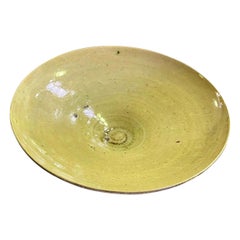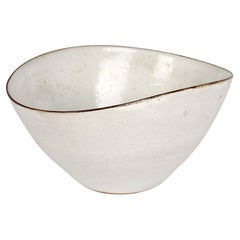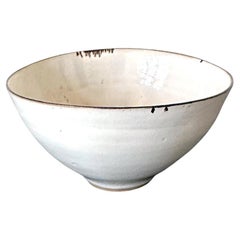Lucie Rie
| Styles |
| Materials |
| Related Creators |
Lucie Rie & Hans Coper Studio Pottery Mustard Glazed Bowl
By Hans Coper, Lucie Rie
Located in Bishop's Stortford, Hertfordshire
A stunning vintage British studio pottery bowl by Lucie Rie and Hans Coper, finely thrown the outer body decorated in oatmeal glaze with a dark ...
Category
Mid-20th Century English Mid-Century Modern Lucie Rie
Materials
Pottery
Lucie Rie & Hans Coper Signed Stamped Yellow Glazed Stoneware Bowl, circa 1950
By Hans Coper, Lucie Rie
Located in Studio City, CA
A gorgeous mustard-yellow glazed stoneware bowl with manganese rim by famed European potters Lucie Rie & Hans Coper.
The bowl is signed with each artist's impressed seals on the b...
Category
1950s English Mid-Century Modern Vintage Lucie Rie
Materials
Stoneware
$12,500
H 2.5 in Dm 5.25 in
Lucie Rie Manganeze Rim Bowl 1980
By Lucie Rie
Located in Munich, DE
Bowl with manganese rim. Circa 1980. Porcelain. White, partially stone-grey and sand-colored grading and speckled glaze. The rim of the mouth inside and outside with a wide, bronze-c...
Category
1980s English Mid-Century Modern Vintage Lucie Rie
Materials
Porcelain
Lucie Rie Signed Stamped Yellow Speckle Glazed British Pottery Bowl, circa 1950s
By Lucie Rie
Located in Studio City, CA
A gorgeous earth-toned, yellow, green, brown speckle glazed ceramic footed bowl by famed Austrian-born British potter Lucie Rie.
The bowl is signed with Lucie Rie's impressed seal on the base.
A rare and unique work. Simply a must for any collector of Rie's work or a beautiful stand-alone piece sure to light up any setting.
Dame Lucie Rie...
Category
1950s English Mid-Century Modern Vintage Lucie Rie
Materials
Pottery
$9,500
H 2.25 in Dm 7.75 in
Lucie Rie 'Austrian/British, 1902-1995' Squeezed Oatmeal Glazed Pottery Bowl
By Lucie Rie
Located in Bishop's Stortford, Hertfordshire
Stoneware oatmeal glazed bowl with small crater and speckled inclusions with a wavy rim with a fine manganese glazed edge by Lucie Rie (Austrian/British, 1902-1995) dating from aroun...
Category
1960s English Mid-Century Modern Vintage Lucie Rie
Materials
Stoneware
$8,287
H 2.96 in W 5.81 in D 4.61 in
British Studio Ceramic Bowl with Magnesium Glaze Lucie Rie
By Lucie Rie
Located in Atlanta, GA
A studio ceramic bowl made by Dame Lucie Rie (1902-1995) circa 1950s. The bowl, iconic in the repertoires of the celebrated British potter has an organic form, elegantly posed with s...
Category
1950s British Mid-Century Modern Vintage Lucie Rie
Materials
Ceramic
Dame Lucie Rie, 1950's Porcelain Footed Bowl with Manganese Glaze.
By Lucie Rie
Located in London, GB
This is a great example of a Lucie Rie iconic hand-thrown, footed bowl with manganese glaze.
It is thinly potted and slightly pulled into an ovoid shape with an undulating rim.
The running glaze is subtle whilst adding an individual element to the decoration of the bowl.
The bowl bears the artist's monogram seal mark under.
Lucie Rie was an Austrian-born British ceramics artist. Rie’s works, usually consisting of hand-thrown pots, bottles, and bowl forms, are noteworthy for their Modernist forms.
Born in 1902 in Vienna, Austria, she studied pottery at the Vienna Kunstgewerbeschule, a school of arts and crafts. In 1937, she won a silver medal at the Paris International Exhibition and by the following year, Rie moved to London to flee Nazi Austria.
Once settled in the British capital, she maintained a small studio and continued to produce pottery and small clay objects, including ceramic buttons and jewellery which she sold to support herself.
She was later joined by Hans Coper, a young artist who soon became a partner in her studio. She taught at the Camberwell School of Art from 1960...
Category
1950s English Mid-Century Modern Vintage Lucie Rie
Materials
Porcelain
$12,535 Sale Price
43% Off
H 3.15 in Dm 6.3 in
Dame Lucie Rie (1902 - 1995) ‘Bottle Vase’ with Flaring Rim
By Lucie Rie
Located in London, GB
Dame Lucie Rie (1902 - 1995) ‘Bottle Vase’ with Flaring Rim
Stoneware, blue / white volcanic glaze
’LR’ seal mark to base
Circa 1980
Size: 27.5cm high, 14cm wide, 12cm deep - 1...
Category
1980s British Vintage Lucie Rie
Materials
Stoneware
Browse all Furniture from Lucie Rie
Shop NowCreators Similar to Lucie Rie
Lucie Rie furniture for sale on 1stDibs.
Lucie Rie furniture are available for sale on 1stDibs. These distinctive items are frequently made of ceramic and are designed with extraordinary care. There are many options to choose from in our collection of Lucie Rie furniture, although gray editions of this piece are particularly popular. Many of the original furniture by Lucie Rie were created in the mid-century modern style in united kingdom during the 20th century. If you’re looking for additional options, many customers also consider furniture by Leach Pottery, David Leach, and Poole Pottery. Prices for Lucie Rie furniture can differ depending upon size, time period and other attributes — on 1stDibs, these items begin at $2,876 and can go as high as $46,574, while a piece like these, on average, fetch $12,751.
Questions About Lucie Rie
- What did Lucie Rie make?1 Answer1stDibs ExpertApril 5, 2022Lucie Rie was an Austrian-British artist who created hand-thrown ceramics known for their modern form and bright colors. The majority of her pottery includes pots, bottles, vases and bowls. You’ll find a selection of Lucie Rie ceramic pottery from some of the world’s top dealers on 1stDibs.
- What is Lucie Rie known for?1 Answer1stDibs ExpertApril 5, 2022Lucie Rie is known for her pottery. The Austrian-British artist became famous for producing vases, bowls and pots in a sleek style influenced by Modern art of the early 20th century. You can find a collection of Lucie Rie pottery 1stDibs.
- 1stDibs ExpertApril 5, 2022Lucie Rie is a ceramics artist celebrated for her use of bright colors for her Modernist hand-thrown pots, bottles and bowls. You can shop a selection of pieces by Lucie Rie from some of the world’s top art dealers on 1stDibs.
- 1stDibs ExpertApril 5, 2022British potter Lucie Rie used a number of different clays over the course of her long career, sometimes using more than one kind in a single piece. Her works were usually of stoneware or porcelain. On 1stDibs, shop a collection of genuine Lucie Rie pieces from some of the world’s top art dealers.







